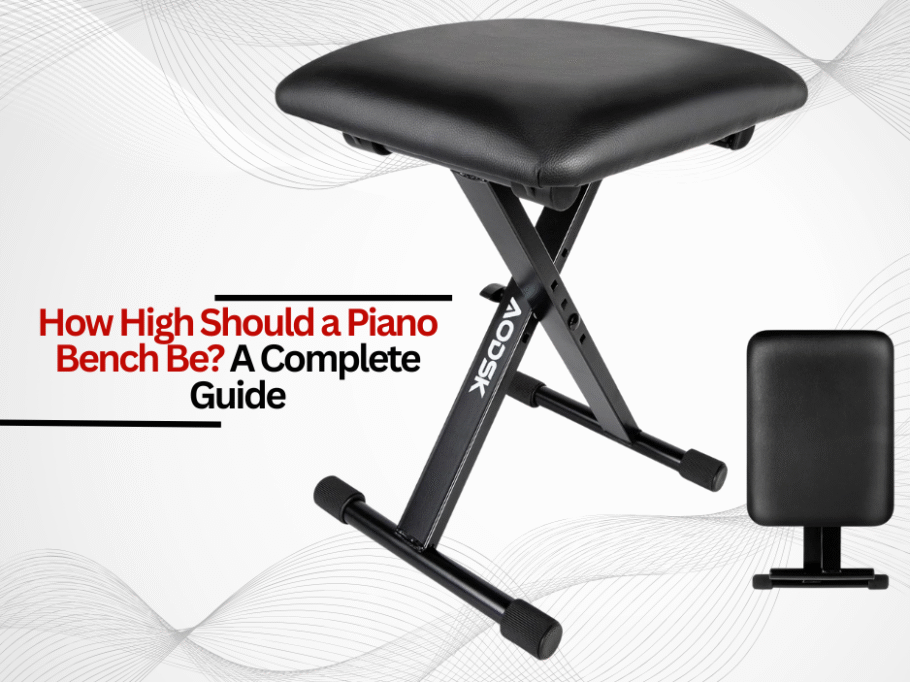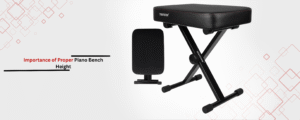In practice and performance, the comfort-related height of a piano bench is usually ignored, even though it is critical in ensuring posture and technical precision. Bench height that is too low or too high can lead to fatigue, inefficient mechanics while playing, and in severe cases, chronic muscle strain in the long run. This guide analyzes the principles of height adjustment, working towards a solution that can scale for every level of pianist.
To know more, read: From Wooden Stools to Adjustable Benches: The Journey of Keyboard Seating
Why Is Optimal Piano Bench Height Important?
The height of a piano bench is very important and must be maintained at a level that is fully ergonomic in order to avoid straining the wrists, shoulders, and spine during long sessions of playing the piano. With proper height adjustment, the bench can allow the forearms to be parallel to the ground which helps in neutral wrist position which assists in finger movement and strong control. Too low or too high of a bench can result in exhaustion, restricted blood flow, or chronic pain. On top of that, ergonomically designed seating aids in supporting proper posture, enabling musicians to concentrate on their craft instead of the discomfort that arises from poor seating. Adjustable benches can be set according to the user’s body dimensions and even the type of instrument, which allows use with grand pianos, digital keyboards, and even hybrid setups. This highlights the fact that if ergonomic principles are prioritized, the chances of performance-related injuries increase considerably while still ensuring efficiency in playing for many years to come.
The Importance of Proper Piano Bench Height
Ergonomic Principles and Posture:
When it comes to the proper height of a piano bench, advanced-level performers have greater chair height adjustability in most cases. The standard height order helps in promoting optimal spine positioning, which in turn eases the stress in the neck, shoulders, and lower back. While seated, arms need to be in a position where they are perpendicular to the keyboard or turned slightly above it while the forearms remain horizontally aligned—the wrists must be floppy or supple. Usually, discomfort and slumping are a sign of overly low or high benches.
Impact on Performance and Technique:
The subtle changes in height affect overall access to the full scope of any keyboard. Carefully edited benches worsen the situation in regards to accuracy through the use of expression and pedal control. Other accuracy-defeating techniques, such as legato and staccato, require a constant change in the played posture for precision.
Finding the Optimal Bench Height
Standard Guidelines for Bench Height:
The height of most piano benches is set between 19 and 22 inches, as it fits most adult players. Nevertheless, some measurements, like torso length, arm span, and leg length, may require further refinement. As a common practice, it is ideal that the elbow remain a bit higher than the keyboard when the hands are playing on the keys.
Modification for Different Sizes:
Taller individuals might need benches with risers or those that are adjustable with greater height ranges (up to 24 inches). On the other hand, shorter students and children may prefer height-increasing platforms, cushions, or benches that have legs that can be adjusted. It is also essential to take into account the weight distribution, seat depth, and the possibility of sliding with regards to balance.
Personalizing the Arrangement
Devices for Height Adjustment:
Most adjustable benches come with hydraulic lifts, spindle cranks, and even custom-threaded bolts for specific modifications. With fixed benches, users can use aftermarket items like risers and padded cushions to customize the bench. For acoustic pianos, the use of rubber-footed benches is advisable to prevent movement while playing.
Children’s Special Considerations and Shared Benches:
Emerging musicians or shared studio spaces benefit from using benches with memory presets or dual-height features. Lightweight, foldable designs permit swift alterations between users, while soft cushions offer makeshift solutions for younger players.
Conclusion
Finding the correct height of a piano bench involves a blend of ergonomic research and personal preference. Piano bench brands like Roland, 5 Core, and K&M offer a variety of options ranging from adjustable to artist-crafted benches. Current recommendations focus on alignment or mobility, but what the future holds for piano benches remains to be seen—smart ergonomics and sustainable materials may redefine what we consider standards. We may not be able to predict what the future holds for us, but the pursuit of the perfectly aligned bench will always be crucial to achieving musical precision.




